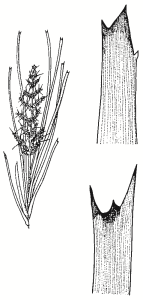Family:
Lomandraceae
Lomandra longifolia
Spiny-headed Mat-rush
Other Names: Cockies bootlaces

Regional Subspecies:
Occurrence:
Regional:
Noted on the drier sites of most areas in region.
Habitat & Site Selection:
Various habitats. Very hardy. Prefers moist well-drained soil and semi-shade. Tolerates dryness, poor drainage, waterlogging to 10 cm deep, and full sun to full shade.
Habit:
Tufted perennial herb with leaves usually 50-100 cm long. Creamy or yellow, strongly honey-scented flowers in spring.
Seed Collection:
Mid Dec to early Mar. Monitor closely as mature seeds shed quickly.
Propagation:
From seed, or division of clumps using garden fork. Germinates in 8-10 weeks from fresh seed. Seedlings usually grow strongly.
VALUES:
Shade & Shelter:
Low-level shelter.
Land Protection:
Excellent for stabilising banks.
Wildlife:
Excellent habitat for ground fauna. Food for butterfly caterpillars and insect-eating birds. Attracts seed-eating native birds. Food plant for caterpillars of native butterflies and moths.
First Nations:
Tough leaves used for fine baskets, mats, eel traps and for binding wounds.
Ornamental:
Useful ‘accent’ plant in mixed groupings with shrubs, beside ponds and under trees. Feature in open spaces, such as traffic islands and around large buildings. Excellent in containers.
Other:
Nectar and leaf bases edible.
